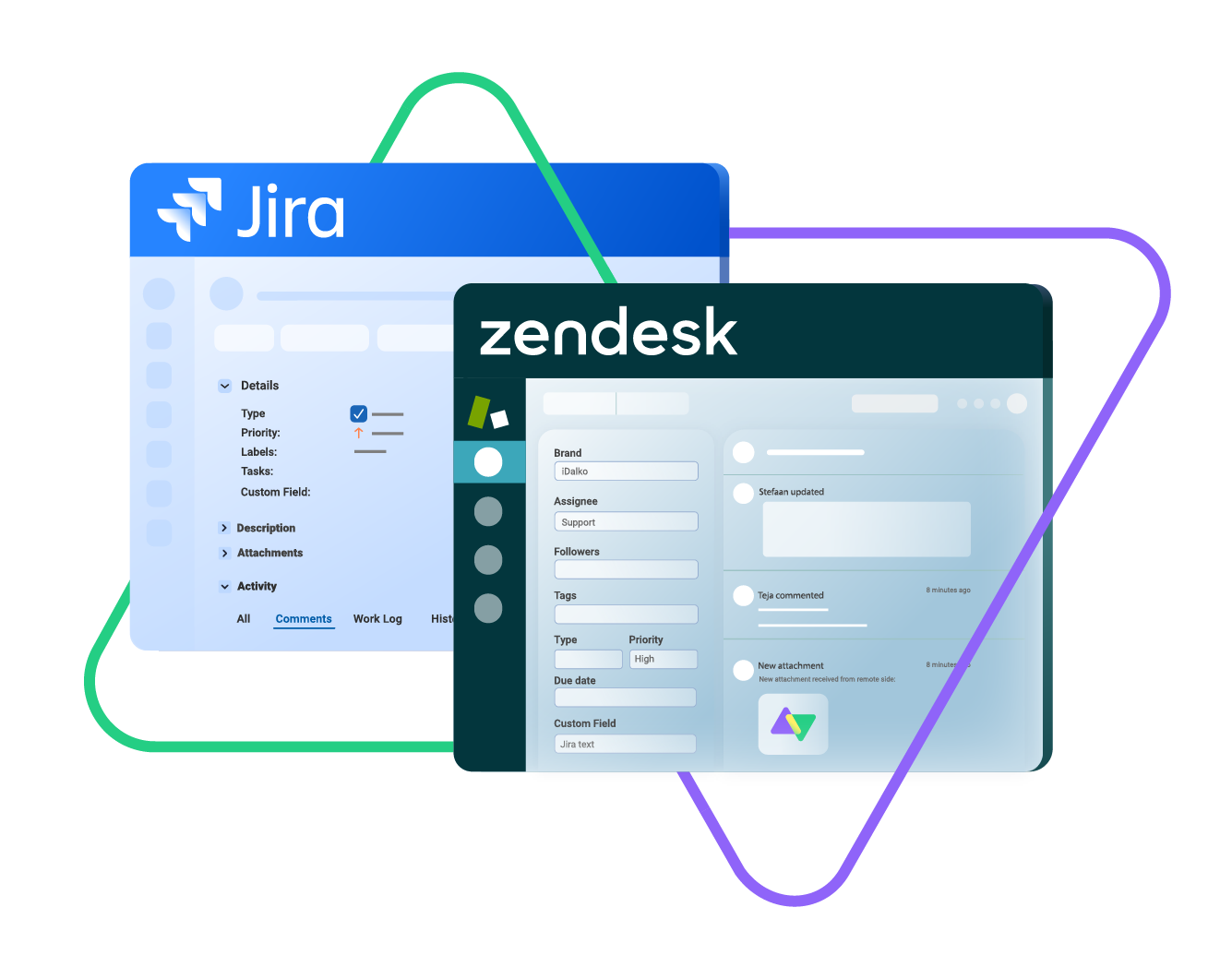We often use various applications, like CRMs, ERPs, etc. to share common projects, statuses, or workloads with other teams, not often physically co-located. You might already be familiar with Jira, Salesforce, ServiceNow, Zendesk, and the like. These applications are useful for time tracking, handling workflows, managing project statuses, etc.
However, teams often face challenges while dealing with these multiple applications. Handling data communication between these applications using diverse technologies is one such challenge.
Integration plays a major role in enabling communication across applications leading towards a holistic digital transformation of your company. You can now connect with your partners, suppliers, or vendors, possibly using a completely different application. We like to call this “cross-company integration”. An eventual outcome of this cross-company integration is a globally connected network of companies striving towards common business goals.
But when it comes to multiple companies and collaborations amongst them, you need to tread carefully. In this article, we present our vision of a “Global network of connected companies” while discussing all that there’s to know about cross-company integrations.
So Where Did It All Start?
Before the commercialization of the Internet, companies were oblivious to integration and never felt the need for it.
Then the Internet boomed, and suddenly, everyone wanted to digitize their daily work. The means to achieve this digitalization using software applications, those that helped automate business processes, structure information moving through a company, enhance decision-making capacities, and optimize results, was felt more than ever.
Task management systems like project management tools, issue trackers, and enterprise-wide applications were founded to fulfill this desire. They helped streamline collaboration within teams, manage workflows, optimize cycle times, and allow for timely escalations. The result was increased productivity and efficiency.
And Task Management Systems Multiplied…
Then, as a natural progression, there were way too many such applications. Teams rapidly adopted them due to their exponential growth. People happily managed their day-to-day work, set deadlines, and met them smoothly. Because, essentially, that’s what was meant to achieve in the first place.
There came a time when people realized that they were working fine within a single team. However, when it came to collaborating with another team using a different application from theirs, they faced issues.
How do they communicate with a system that has completely different technologies, APIs, deployment models, data mappings, and workflows?
They needed automatic, accurate, real-time information exchange.
The result of this need was integration. However, it is an uphill task.
Integration between teams involves aligning processes and mapping data between diverse systems while keeping the internal workflows intact. It must also be easy to maintain, scale, and secure.
This is a huge undertaking, even with teams located within a single organization belonging to different departments. What about teams you want to integrate with who are outside the company? All of the things we talked about just multiplied in complexity. And what about security? That’s exponentially more complicated with a cross-company integration.
And this is precisely the reason why we want to share this journey with you. To make it smoother and better.
The Cross-Company Integration Journey
Companies benefit by connecting and collaborating with each other. Consider a supply chain organization where a retailer generally depends on other product suppliers, who in turn, may be dependent on different independent suppliers.
For all of these companies to seamlessly work together and move products and services between each other, integration is needed. You can track delivery issues with a lot less friction by integrating the quality management system with the task-tracking systems of the suppliers: a classic example of cross-company integration.
So, let’s discuss how this cross-company journey started evolving by understanding the ways in which companies try to connect with other companies in the first place.
Manual Copy-pasting of Information
The first resort is to manually exchange information via phone calls, emails, copy-pasting, messenger apps, and countless meetings. But all this results in inaccurate, misplaced, or altered information. Statuses remain unclear, service levels are missed, and even wrong escalations happen at times.
The manual method has some disadvantages but is still adopted for a variety of reasons
- reluctance to invest in integration strategies,
- data security concerns,
- not enough understanding of data needs,
- governance issues, or
- it seems to be the most viable option.
However, every step of this process is prone to manual errors and can ultimately defeat the purpose of integration.
Sharing the Environment
Another common approach companies follow is to share their environments with one another, like adding new users to their systems or allowing access to their instances. This may seem logical at the beginning, but it is not always convenient. Imagine having to log into an unfamiliar environment every time you need a piece of information.
There is also a high risk of exposing sensitive information to unauthorized users. Proprietary data is prone to risk, not to mention GDPR requirements.
Native Integrations Between Apps
Software vendors have since long recognized the need for allowing native integration between popular applications. You can easily set up a Jira Zendesk integration natively, for instance.
You can use such native integrations that are built for common scenarios with predefined templates if your use case is simple and straightforward. They are also easier and quicker to set up. For instance, you can automate a unidirectional flow between Jira and Zendesk, such that when a high-priority ticket arrives in Zendesk, it automatically triggers a dev issue in Jira.
However, over time, it does not allow for customization and lacks the flexibility an integration demands.
Build Your Own Integration
The next obvious step that companies take is to contemplate the build-vs-buy decision.
With multiple companies involved in the integration process, many choose to build the integration in-house due to ample availability of technical expertise and resources, covered expenditure, fulfilled data security requirements, and a custom-tailored integration.
Another reason why companies also choose to build in-house is the lack of knowledge of integration solutions that offer the flexibility and automation they desire.
At first glance, this seems to be a better proposition, and that might be true, but only initially. The upfront costs of building an integration might be relatively low, but with time, maintenance costs go off the roof.
Also, since integrations mature with time and so do their requirements, fulfilling them with built-in integrations can be time-consuming and costly, putting additional stress on critical technical resources.
Moreover, internal teams need to be more diligent in maintaining documentation. So when the key talent leaves, the system becomes unwieldy to continue.
3rd-party Integration Solution Providers
Perhaps the most logical outcome of all our discussion here is using third-party integration solutions.
Firstly, they are experts in what they do, so getting an integration up and running is faster.
Secondly, they provide the architecture necessary for getting the information flowing between the organizations and alleviate the issues of having to do that on your own. They also provide connections between hybrid cloud environments like connecting a cloud instance with an on-premise one.
Thirdly, they have elaborate training, support, and documentation handy to answer any or all of your integration questions.
Fourthly, since integrations are their bread and butter, newer, custom-made, and complex (or advanced) integration requirements can be implemented without any additional hassle. They support diverse integration methods like webhooks, APIs, middleware, etc.
The initial cost of using third-party integration tools might seem higher, but with time the maintenance and customization costs are drastically reduced.
iPaas is a type of third-party integration solution provider that is gaining a lot of traction.
iPaaS (Integration Platform as a Service) Solution
iPaaS (Integration platform as a service) offers cloud-based platforms and services specifically designed to integrate various third-party applications and systems.
These platforms help connect different software applications, services, and data sources, allowing organizations to automate workflows, share data, and improve overall business processes.
iPaaS providers typically offer a range of features and tools, such as pre-built connectors, low-code/ no-code development environments, centralized management dashboards, monitoring capabilities, and security controls. iPaaS vendors are a subset of third-party integration solution providers, focussing specifically on cloud-based integration platforms and services.
We can envision a lot of possibilities with the right third-party integration solution. One such possibility is to develop your integration network with your partners.
For that to happen, let’s discuss the types of networks that exist.
Types of Cross-Company Networks
Companies establish different types of connections between the applications they use. It can be a direct connection between systems or can be via a standard, central UI.
Peer-to-Peer Integration
The first step companies usually adopt is to create a one-on-one integration connection between themselves and their integration partners. It essentially means you have a point-to-point connection with a single other company. This option is cost-effective and simple to implement.
However, the simplicity of a peer-to-peer connection is also a disadvantage. It is difficult to scale this integration network.
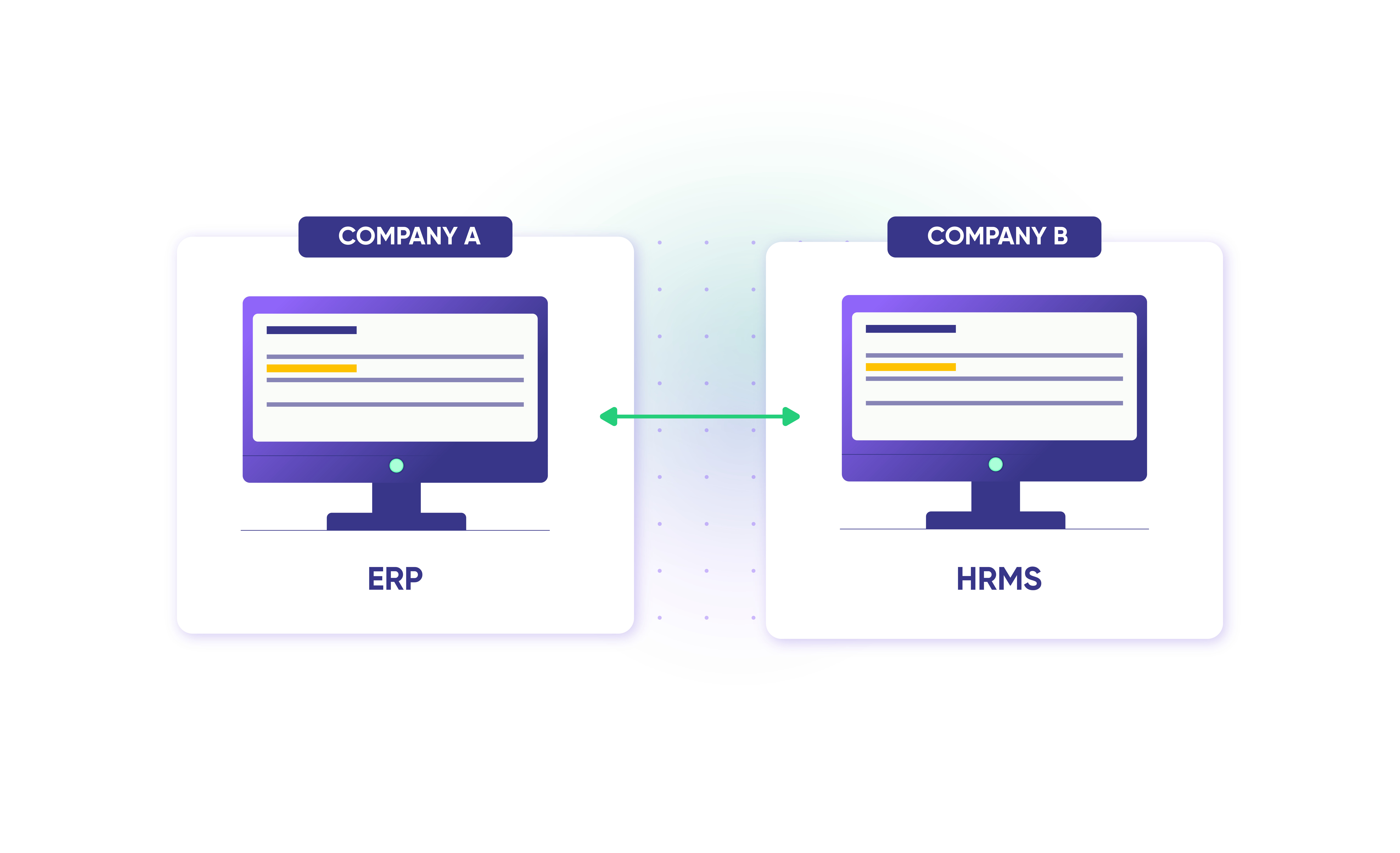
Star Networks
Star connections are also called a hub and spoke model, a popular approach that many companies adopt.
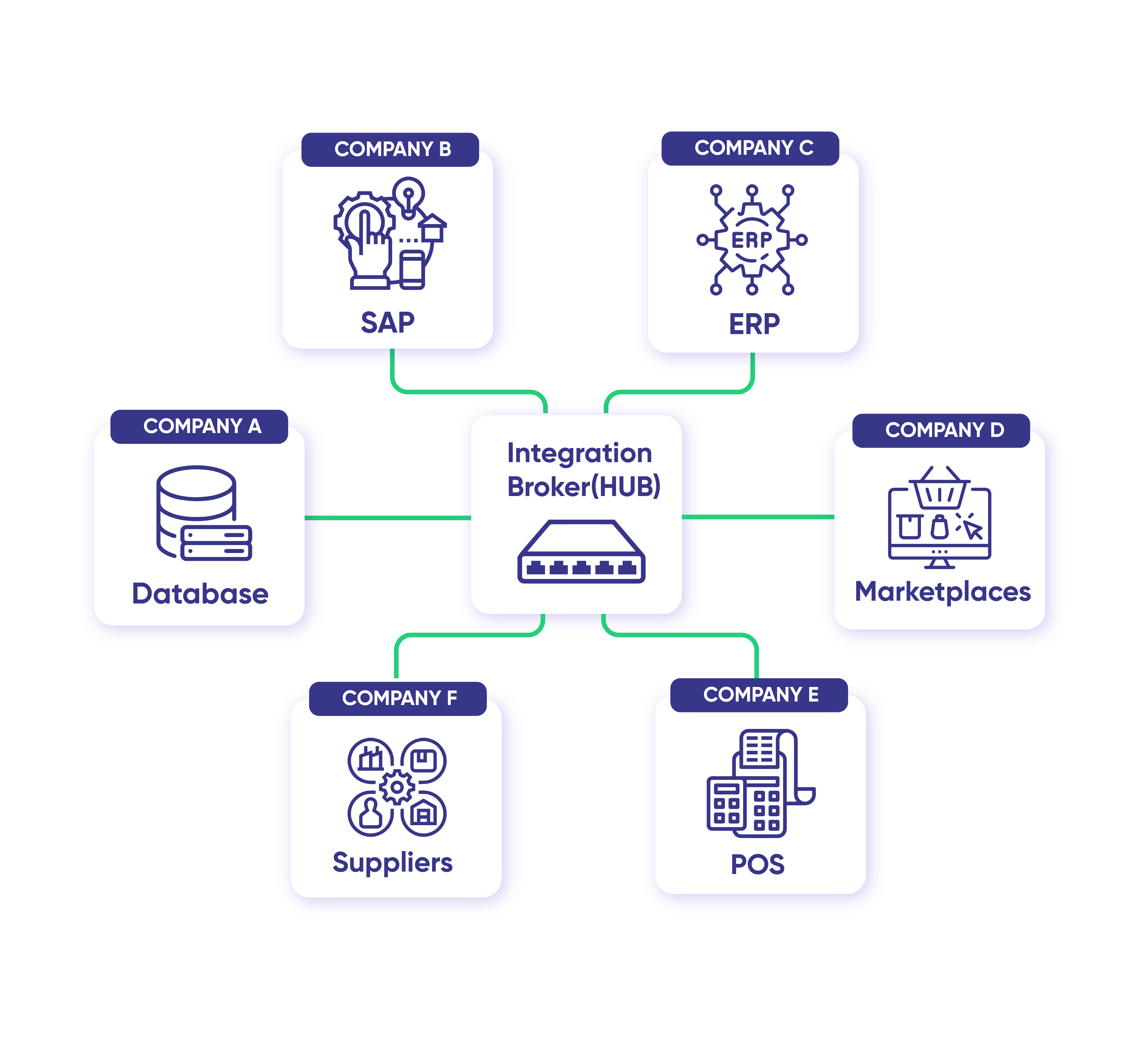
The hub works as a central entity. Other entities connect to the hub as spokes. So, every single company has a direct connection to the hub. Note that connections between the spokes are possible, but then the star network becomes a meshed network.
ESB (Enterprise Service Bus)
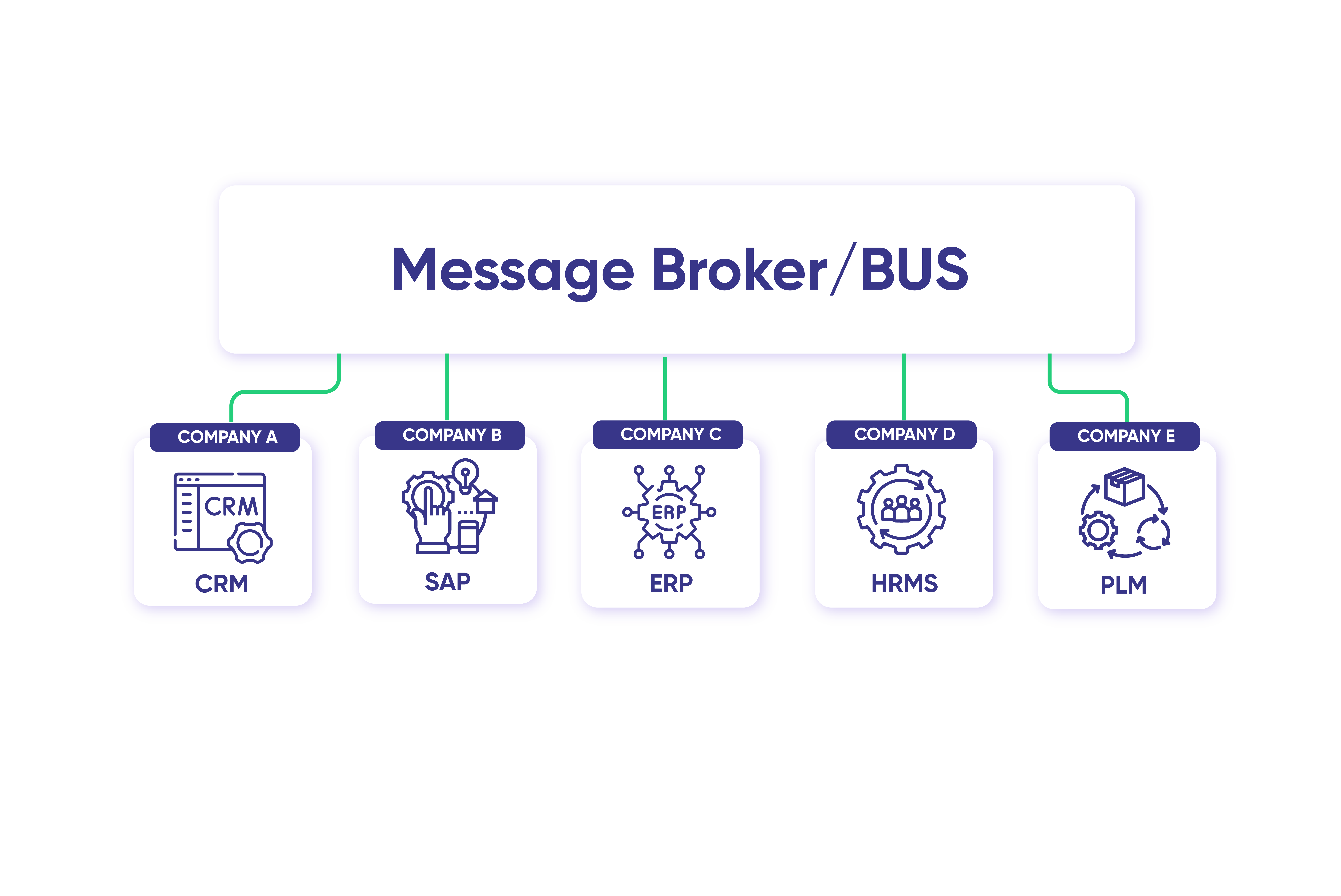
Sometimes entities can also be connected in a serial or a train-like fashion. Its simplicity makes it easy to adopt, but this type of arrangement can create inefficiencies in the workflow and can be difficult to manage.
Meshed Network
A sophisticated version of a peer-to-peer connection is creating a mesh network. In this type, every company can have multiple connections, all of them connected in a mesh pattern.
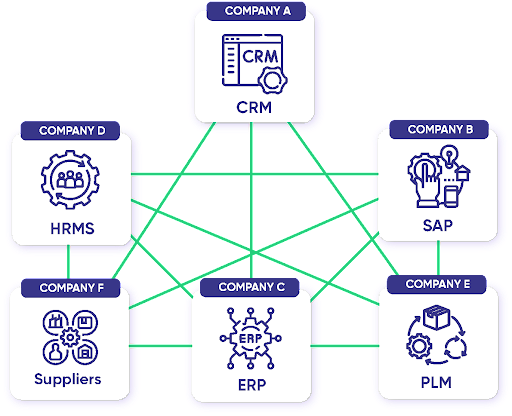
So you no longer have the limitation to connect to a single other company. This kind of network definitely holds the promise of optimal workflows across all of the integrations.
To implement these various network models and connections, we saw why using an integration solution is the best option.
However, it’s also important to understand how these solutions have evolved over the years and how modern enterprises can leverage them for cross-company integrations.
Evolution of Integration Technologies
The evolution and rise of modern integration solutions can be traced back to the increasing complexity of IT systems, the growth of digital technologies, and the need for organizations to streamline their operations, improve efficiency, and deliver better customer experiences.
Early System Integration
Before the widespread use of the Internet and digital technologies, organizations primarily relied on point-to-point integration solutions to connect different software and hardware systems. This was implemented using EDI (Electronic Data Interchange).
These integrations were often custom-built and costly to maintain. They lacked scalability and flexibility.
The Rise of Internet and Web Services
The advent of the Internet and the development of web service standards like SOAP and REST revolutionized integration. Web services allowed applications to communicate over the internet using standardized protocols, making it easier to connect systems across different platforms and locations. This led to the emergence of SOA (Service-Oriented Architecture).
Enterprise Service Bus (ESB) and Middleware
ESBs and middleware platforms became popular as they provided a centralized hub for integrating various applications and services. ESBs allowed for message routing, transformation, and mediation, making integrations more manageable. However, ESBs were often seen as complex and costly.
Cloud Computing
The rise of cloud computing introduced new integration challenges. Organizations needed to integrate cloud-based applications residing on private clouds, public clouds, or hybrid clouds. Cloud-based Integration Platform as a Service (iPaaS) solutions emerged to address this need, offering scalable, cloud-native integration capabilities.
The proliferation of APIs (Application Programming Interfaces) at this time fueled the API economy, making it easier for organizations to expose their services and data to external partners and developers. API management platforms and API gateways became critical components of modern integration solutions.
Microservices and Containers
The adoption of microservices architecture and containerization technologies like Docker and Kubernetes led to a shift in integration patterns. Integrations became more fine-grained, with each microservice responsible for its own data and interactions. Tools like service meshes and container orchestration platforms added a new layer of complexity but also enhanced flexibility.
The evolution and the future of modern integration solutions have been driven by the changing technology landscape, the need for greater agility and scalability, and the growing importance of data and real-time interactions.
The Future of Integration
Let’s peer into the crystal ball and glimpse what the future holds for integration.
Low-Code and No-Code Integration
To democratize integration and reduce the reliance on highly specialized developers, low-code and no-code integration platforms have gained popularity. These platforms allow business users to create integrations with minimal coding, accelerating digital transformation efforts.
Hybrid and Multi-Cloud Integration
As organizations increasingly adopt multi-cloud and hybrid cloud strategies, the need for seamless integration between on-premises and cloud-based systems continues to grow. Modern integration solutions provide the flexibility to connect disparate environments, giving rise to HIPs.
HIP (Hybrid Integration Platform)
HIP (Hybrid Integration Platform) enables organizations to seamlessly integrate cloud-based applications (public/ private) and on-premise ones and makes them work as a single unit.

It works on two basic principles:
- Provide a way to handle the different protocols every application has. For instance, HTTP, TCP, etc.
- Convert data into a common format that is understandable and makes sense to the integrating systems. For instance, JSON, XML, etc.
AI and Machine Learning Integration
The integration of AI and machine learning capabilities into business processes is becoming more common. Modern integration solutions often include AI-driven features for data transformation, prediction, and automation.
Next-generation middleware, based on AI capabilities will ensure accurate mapping, transformation, and business process automation between systems.
However, you need to be mindful of the adverse effects of this AI boom. For instance, it’s important to avoid AI hallucinations, resulting in incorrect or unacceptable assumptions or answers to integration problems. To work on the complexities of integrations, use AI to actively research and come up with the best approach.
Exalate: A Cross-company Integration Solution
Today’s integration solutions need to be more agile, distributed, scalable, and user-friendly than ever before, enabling organizations to connect to external partners and applications without any hassle. The solution they need must also rapidly adapt to changing business requirements and handle the ever-evolving data volume.
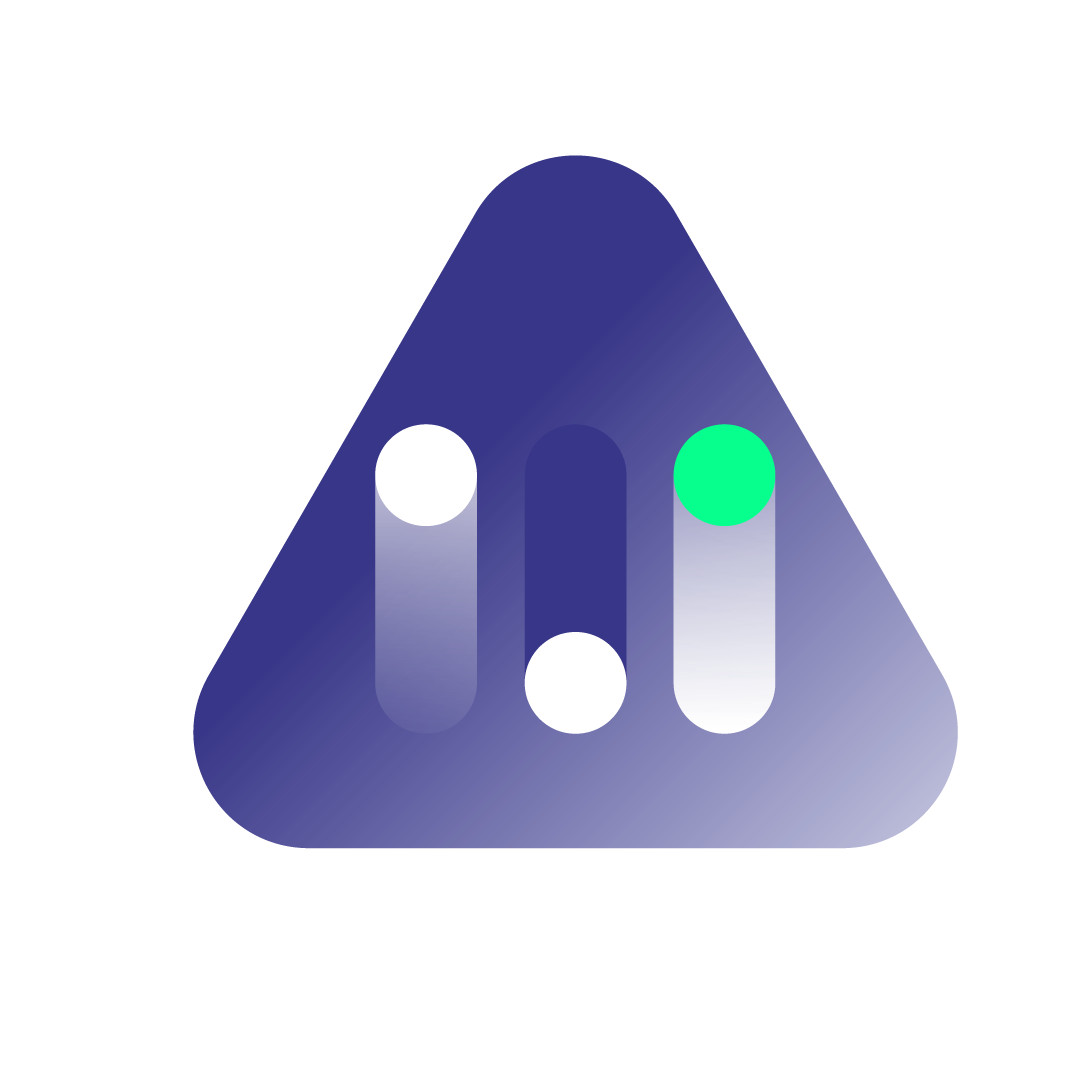
In this world of rising integration solutions, the answer to all of the requirements above is Exalate.
Exalate is a modern integration solution that has some unique features and is a perfect fit for a cross-company (or intra-company) integration scenario. It provides uni or bi-directional synchronization in real time between different applications like Jira, ServiceNow, GitHub, Azure DevOps, Zendesk, Salesforce, etc.
Some key Exalate features are:
- It can be deployed on the cloud as well as on your on-premise applications, paving the way for hybrid integrations.
- It is the only solution that supports decentralized integration.
Decentralized integration allows you to independently control the information you share and receive. This is contradictory to the usual centralized integration architecture that forces you to control integration settings through an uncommon, often unfamiliar UI. It’s also necessary to maintain any integration changes in the common interface (UI).
With decentralized integration, you can decide what to send and receive without keeping the destination admin in the loop. Well, involve them the first time you set up the integration, but after that, you have complete control over your incoming and outgoing information.
In a cross-company scenario, this can be a huge differentiating factor. For instance, workflows are hugely specific within a single company, and it becomes difficult to orchestrate them with another company with a different workflow. Neither of them wants to modify their workflows or build a new one while still wanting to get the information they need within their application. With a decentralized integration solution, each company initially contributes toward setting the expectations of the workflow. And once that is done, each side can independently make decisions without worrying about how it affects the destination.
- It has a distributed architecture that ensures the integrating systems are loosely coupled and that the admins will not mess up each other’s sync. This increases the scalability and maintainability of your integration. For this reason, Exalate needs to be installed on both sides of the integration.
- It offers a no-code/ low-code integration approach.
The low-code approach uses an intuitive Groovy-based scripting engine that comes with sync processors to control incoming and outgoing information independently on both sides. These processors can map, transform, filter, and sync any information, the way you want. This scripting capability allows Exalate to accommodate even the most complex integrations.
- It has a reliable transactional sync queue that allows it to resume synchronization from the point of interruption in case of downtimes or system failures.
How Exalate Envisions Growth Towards A Worldwide Network?
At Exalate, we acknowledge that integrations are complex, and so we make them simple for our customers.
Exalate for a P2P (Peer-to-Peer) Connection
If you are an organization that wants to connect to a single other department, team, or company you can establish, what we like to call, a P2P connection.
For instance, your dev team works in Jira and your customer support team relies on Zendesk. With the help of an Exalate P2P connection, you can connect your dev and support teams, so they always remain on the same page. If you choose to automate your dev workflow or streamline the customer support process, all of your needs will be handled. The no-code and low-code modes in Exalate allow you to implement basic to advanced integration scenarios.
Book a demo with an integration engineer to see this in action.
Exalate for MSPs
If you’re an MSP or MSSP, we know you struggle with disconnected customer environments, waste time and effort in manual data exchange, have security concerns, and want to maintain a balance between growth and service quality as you scale.
The Exalate for MSPs is an A-Z service that handles tickets, issues, incidents, or tasks integration across your teams and organizations. With this program, you can expect enhanced service management, efficient incident management, enabled cross-company project management, and much more.
We implement end-to-end integration with your partners or customers, offer dedicated support and maintenance, tailor-make your connections for legacy systems, and ensure top-notch security and stability.
Discuss your integration use case with us and find out how Exalate can help you grow faster and at scale.
What after this? Do we stop? Or do we dream bigger?
Can your cross-company integration effort as an MSP lead to a global network of connected companies?
A network where all the companies have streamlined communication between each other and information exchange takes place at the flip of a switch.
A Global Network of Connected Companies
At Exalate, we envision a global network of connected companies.
Imagine an MSP operates its own integrated network which involves a range of applications catering to specific business functions. The network can be any of the ones we discussed, like peer-to-peer, hub and spoke, etc.
Such an MSP wishes to integrate with another independent (or outsourced) entity either one of its customers, partners, vendors, or suppliers. Each of these external parties operates its own integrated network with a different technology stack.
There is a need to connect these fragmented networks that are fully distributed with no central operational control. Each system in the network is motivated to ensure there is end-to-end connectivity of every part of the network.
Such a connected network of companies ensures integration is an intrinsic business strategy rather than an afterthought. It blurs organizational boundaries and not only integrates information but also people, ideas, and processes.
The journey toward creating this global network of connected companies is a path paved with innovation, collaboration, and adaptability. Exalate will ensure you reach the end of this journey and continue to thrive in an interconnected world.
What Lies Ahead?
At our core, integration is part of our DNA, and with great enthusiasm, we venture into the dynamic realm of ChatGPT. We grasp the significance of staying at the forefront of innovation and are currently delving into the possibilities AI technology offers to enhance Exalate’s capabilities and reach a wider audience. Our unwavering commitment lies in executing these advancements effectively, precisely, and with utmost security in mind.
Exalate AI Services
We are embarking on three primary AI-driven initiatives:
1. Exalate for ChatGPT: We’re infusing AI into our support portal to elevate the efficiency and performance of our support services and operational processes.
2. Assisted Integration: Within Exalate Script Mode, we’re creating a feature that operates as a collaborative co-pilot for Github, simplifying integration tasks.
3. Auto-generated Integration: We’re charting a course to introduce a feature that enables you to present your use case and initiate integration with a single click, while AI takes care of the rest. This promises to streamline the integration creation and maintenance process.
Conclusion
Integration (intra or cross-company) is a humongous task in itself. The complexities and requirements of such an integration are more stringent and advanced in a cross-company setup. Security needs grow manifold and they need to be handled by some advanced features.
We saw how decentralized integration with advanced integration capabilities can help alleviate these security concerns and yet provide autonomy in handling your data the way you want.
Exalate is one such integration solution that has been around for a while and is an expert in decentralized integration. It is also flexible enough to handle the deepest integration requirements via its scripting engine. And more than that, it helps you put integration at the forefront of all your business needs.
And at the end of it all, it stands by its vision of creating a global network of connected companies.
Recommended Reading:


